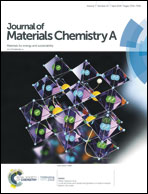Predictive fabrication of Ni phosphide embedded in carbon nanofibers as active and stable electrocatalysts†
Abstract
Although numerous first-principle studies have suggested candidate materials that may be used as enhanced electrocatalysts, the synthesis of such materials is quite another challenge. Furthermore, it has been still necessary to combine the active material with a supporting matrix in an optimized structure for stability and surface accessibility. Herein, we report a predictive fabrication method for the system where NiP2 nanoparticles has beenevenly embedded in carbon nanofibers (CNFs), which is expected to be superior by theoretical calculation but not successfully made so far. Through thermodynamic considerations on the inter-component reactions against processing variables, such as temperature, partial pressure of oxygen and phosphorus (pO2, pP4), a suitable two-step synthesis route consisting of successive pO2-controlled carbonization and pP4-controlled phosphidation was deduced. The obtained NiP2/CNFs had the desired electrocatalytic properties as well as physical features, including maximized surface area and well-combined structure. Consequently, the catalysts had overpotentials of only 71 mV at 10 mA cm−2 and long-term stability of over 100 hours with less than 10% degradation under the operating conditions.



 Please wait while we load your content...
Please wait while we load your content...